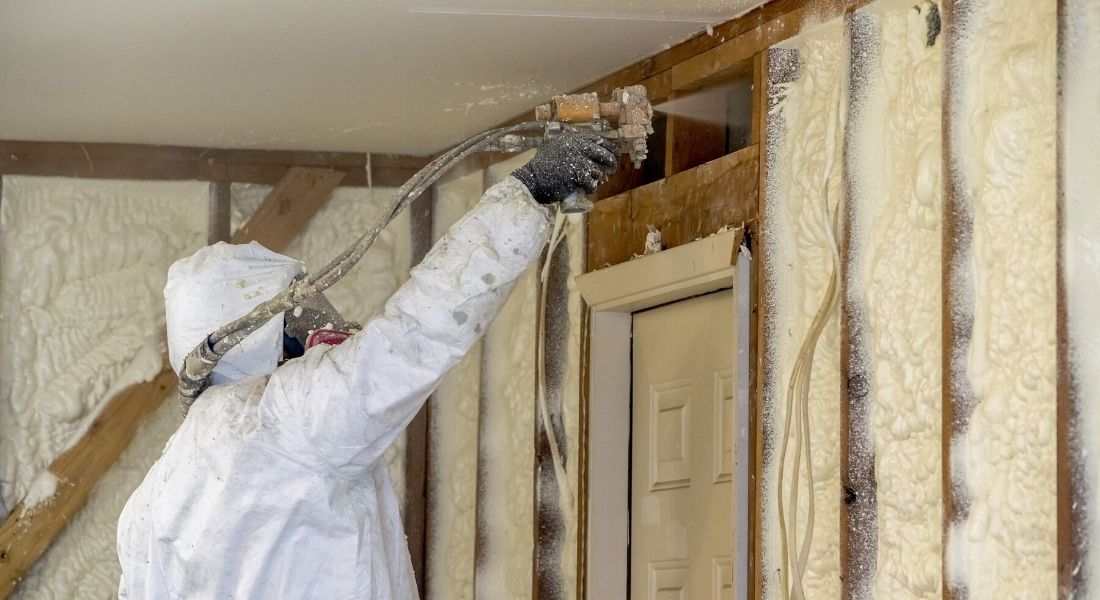What is Spray Foam Insulation Made of? Components Explained
Do you know what's in spray foam insulation? This insulation is great at keeping your home warm and stopping air leaks. So, what makes it work so well? We'll look at the ingredients of this top-performing Vega Bond V600 insulation kit.

Spray foam comes from polyurethane and isocyanate. When these compounds mix, they create a reaction. This reaction causes them to expand and become hard. They're sprayed from a special gun; like Foam Applicator Gun then, they expand to cover an area with insulation.
So, why is spray foam good for the environment? Well, it makes heating and cooling your home more efficient. It's a much better insulator than traditional types. This improvement can help you save a lot on energy bills. Plus, it's good for the planet, making your home greener.
Key Takeaways
- Spray foam insulation is made from a combination of polyurethane and isocyanate materials.
- These two components chemically react when combined, causing the spray foam to expand and harden.
- Spray foam insulation is known for its superior insulating properties, helping to reduce energy costs and improve overall home efficiency.
- The manufacturing process of spray foam insulation involves simultaneously spraying the two components, which then expand to form a protective layer.
- Spray foam insulation is considered a sustainable and eco-friendly insulation option compared to traditional materials.
Introduction to Spray Foam Insulation
Spray foam is a special kind of foam that starts as two separate liquids: isocyanate and polyol resin. When these liquids are mixed, they expand quickly, making them great for wrapping products or filling spaces to keep heat in or out.
Understanding Spray Foam Insulation
Spray foam insulation is a type of polyurethane that fills up spaces completely. It's made from two different liquids. One contains isocyanates. When they're mixed, they create foam that seals up a place well.
Benefits of Using Spray Foam Insulation
It helps stop heat from moving between indoors and outdoors. There are two kinds: open-cell kits and closed-cell kits. The type used depends on the weather and whether a place needs to stay dry. Either way, spray foam helps make buildings more efficient at saving energy.

What is Spray in Foam Insulation Made of?
Two liquids mix when making spray foam. This mix causes a chemical reaction to make the spray polyurethane foam. These liquids are in different drums. One is called the "A" side, and the other is the "B" side.
The "A" Side: Isocyanates
On the "A" side of spray foam, there's methylene diphenyl diisocyanate (MDI) and polymeric methylene diphenyl diisocyanate (pMDI). These chemicals are isocyanates, vital for creating spray foam. They react with the polyols on the "B" side to form the foam.
The "B" Side: Polyols, Catalysts, and Blowing Agents
The "B" side contains polyol resins, catalysts, and blowing agents. Polyols interact with isocyanates to make the foam, and catalysts speed up the process. Blowing agents, like water in open-cell foam, help the foam expand and determine its density and insulating ability.
Chemical Reaction and Foam Formation
When the "A" and "B" sides mix and spray, a quick reaction starts. Isocyanates and polyols make the foam expand and solidify. This speed and the foam's outcome change with the type of foam and environment.

Types of Spray Foam Insulation
Spray polyurethane foam (SPF) insulation has two main types. There's light-density open-cell spray foam insulation and medium-density closed-cell spray foam insulation. Each type has its features and benefits. These make them good for different uses and building needs.
Open-Cell Spray Foam Insulation
Open-cell spray foam insulation is light and fluffy, with a density of about 0.5 pounds per cubic foot. It's not as good at insulating (its R-value is around 3.5 per inch) as closed-cell foam, but it's still valuable. When sprayed, it expands up to 3 inches. That makes open cells ideal for filling small spaces and areas that are hard to access. It's also great for reducing noise and usually costs less than closed-cell foam.
Closed-Cell Spray Foam Insulation
Closed-cell spray foam is denser, with a weight of over 1.75 pounds per cubic foot. This type offers better insulation (with an R-value of 6.0 per inch and up to 7). It expands up to 1 inch, creating a tight, strong barrier. Closed-cell foam has many benefits. It provides more insulation efficiency in walls, improves a building's strength, and can resist water as a vapor barrier. It's also available in versions with a fire safety rating.
| Characteristic | Open-Cell Spray Foam | Closed-Cell Spray Foam |
|---|---|---|
| Density | About 0.5 lbs/cubic ft | Over 1.75 lbs/cubic ft |
| R-Value | Approximately 3.5 per inch | Usually around 6.0 per inch, up to 7 per inch |
| Expansion | Expands to about 3 inches | Expands to about 1 inch |
| Benefits |
|
|
Choosing the right spray foam insulation type is key. It depends on your building's specific needs. VB Insulation offers top-quality spray foam products like Vega Bond V200 insulation kit in the U.S. They focus on providing energy-saving and eco-friendly insulation solutions for homes and businesses.
Eco-Friendly and Energy-Efficient Spray Foam
Most spray foams use petroleum-based chemicals. But top brands like VB Insulation make their foams more eco-friendly. They use less petroleum-based materials and add soy oil or castor oil instead. These soy-based foams are a better choice for the environment and offer a sustainable solution for those building or upgrading their homes.
Soy-Based Spray Foam Insulation
VB Insulation's spray foam is a great example of green technology. It uses soy sources to reduce the impact on our planet. By lowering the need for petroleum, it cuts down on harmful emissions. This foam meets high standards for eco-building practices.
Reducing Environmental Impact
VB Insulation's foam is better for the Earth in many ways. It's made with less harmful chemicals, which means it's a low-carbon choice. This foam product is more efficient than others and helps keep homes comfortable. Homeowners who pick this spray foam are helping the environment, too.
Conclusion
Spray foam insulation is a great way to better your home or building's energy use. It's made of isocyanates and polyols. When sprayed, it expands and becomes a tight barrier. This barrier helps reduce the need for heating and cooling.
It is important to choose between open-cell and closed-cell spray foam. The closed-cell type is better at keeping moisture out and has a higher R-value. On the other hand, open-cell foam is great for quieting sounds and sealing air leaks. Both types help make buildings stronger.
In summary, spray foam insulation is top-notch for saving energy, caring for the Earth, and giving comfort. With VB Insulation's help, your home or office will get the best service and products. It's all about taking good care of your insulation needs.
FAQ
What is spray foam insulation made of?
Spray foam insulation is made by mixing polyurethane and isocyanate. The two chemicals chemically react, expanding and hardening to form the protective layer.
What are the key ingredients in spray foam insulation?
Isocyanate and polyol resin are the main ingredients of spray foam insulation. Mixing them causes a big, up to 30-60 times, expansion. This creates the spray polyurethane foam.
How is spray foam insulation made?
Isocyanate and polyol resin mix at the tip of a spray foam gun during the insulation process. They react, expand, and harden, creating the spray foam insulation layer.
What are the different types of spray foam insulation?
There are two main types of spray foam insulation: light-density open-cell and medium-density closed-cell. They vary in their chemical makeup and how dense they are.
Are there eco-friendly alternatives to traditional spray foam insulation?
Yes, some eco-friendly spray foam formulas use less petroleum-based chemicals in polyol resin. They use soy or castor oil resin instead. These "soy-based" foams are a greener option.




